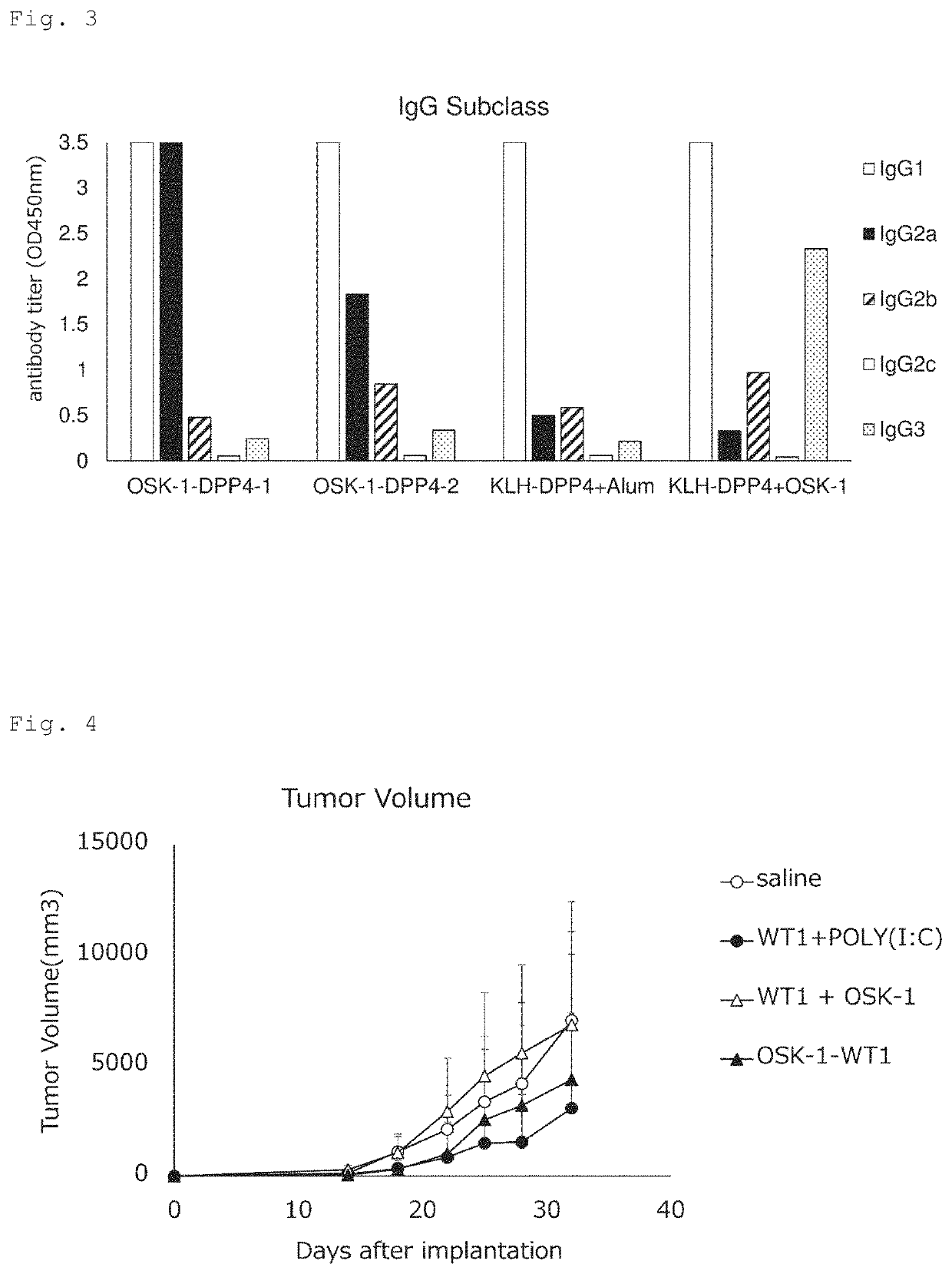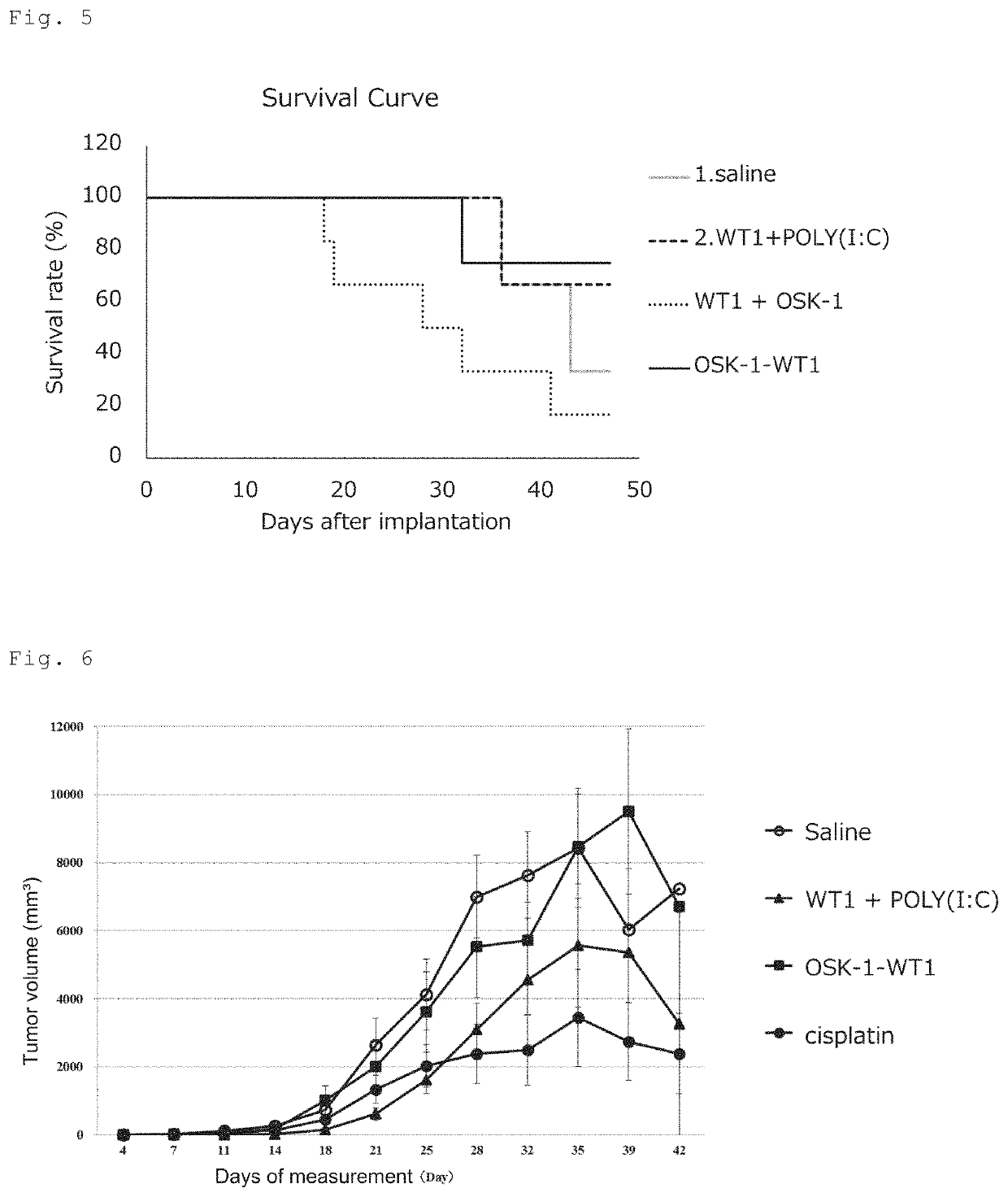Conjugate vaccine targeting a disease-causing biological protein
a technology of biological proteins and conjugates, applied in the direction of antibody medical ingredients, carrier-bound antigen/hapten ingredients, immunological disorders, etc., to achieve the effect of effective vaccines
- Summary
- Abstract
- Description
- Claims
- Application Information
AI Technical Summary
Benefits of technology
Problems solved by technology
Method used
Image
Examples
example 1
on of Antibody Production Induced by OSK-1-DPP4 Conjugate—Part 1
[0091]An OSK-1-DPP4 conjugate composed of an OSK-1 peptide (SEQ ID NO: 1) conjugated to a mouse DPP4 epitope peptide (SEQ ID NO: 17) via an ε-Acp linker (Ac-ELKLIFLHRLKRLRKRLKRK-X-ENSTFESFG (X=ε-Acp)) was assessed for the antibody production-inducing effect. For this test, the following two groups were prepared: a physiological saline group and an OSK-1-DPP4 conjugate group (100 μg / mouse) (6 animals per group). Test samples were intracutaneously administered to Balb / c mice 3 times at 2-week intervals. Before the first administration and every 2 weeks until 8 weeks after the first administration, blood samples were collected, and the antibody titer against the DPP4 epitope peptide was measured by ELISA.
[0092]The results are shown in FIG. 1. After the administration of the OSK-1-DPP4 conjugate, antibody production against the DPP4 epitope peptide was observed.
example 2
on of Antibody Production Induced by OSK-1-DPP4 Conjugate—Part 2
[0093]The antibody production-inducing effect of the same OSK-1-DPP4 conjugate as used in Example 1 was compared with that of a conjugate of KLH (keyhole limpet hemocyanin) and the mouse DPP4 epitope peptide (SEQ ID NO: 17) (KLH-DPP4). For this test, the following three groups were prepared: a KLH-DPP4 conjugate group (20 μg / mouse), an OSK-1-DPP4 conjugate group (100 μg / mouse) and an OSK-1-DPP4 conjugate (100 μg / mouse) plus Alum (Alhydrogel 2% (InvivoGen) 1 mg / mouse) group (2 animals per group). Test samples were intracutaneously administered to Balb / c mice 3 times at 2-week intervals. Before the first administration, every 2 weeks until 6 weeks after the first administration, and 12 weeks after the first administration, blood samples were collected, and the antibody titer against the DPP4 epitope peptide was measured by ELISA.
[0094]The results are shown in FIG. 2. The antibody production-inducing capability of the OSK-...
example 3
of IgG Subclass of Produced Antibodies
[0095]The IgG subclass of antibodies produced by vaccination with the same OSK-1-DPP4 conjugate as used in Examples 1 and 2 was compared with that of antibodies produced by vaccination with the same KLH-DPP4 conjugate as used in Example 2. For this test, the following three groups were prepared: an OSK-1-DPP4 conjugate group (100 μg / mouse), a KLH-DPP4 conjugate (20 μg / mouse) plus Alum (Alhydrogel 2% (InvivoGen) 1 mg / mouse) group and a KLH-DPP4 conjugate (20 μg / mouse) plus OSK-1 (100 μg / mouse) group. Test samples were intracutaneously administered to Balb / c mice 3 times at 2-week intervals and at 9 weeks after the start of the administration, 4 times in total. At 11 weeks after the start of the administration, blood samples were collected, and the titer of each IgG subclass of antibodies against the DPP4 epitope peptide was measured by ELISA.
[0096]The results are shown in FIG. 3. In the KLH-DPP4 conjugate plus Alum group, the titer of IgG1, which...
PUM
| Property | Measurement | Unit |
|---|---|---|
| HPLC | aaaaa | aaaaa |
| thickness | aaaaa | aaaaa |
| concentration | aaaaa | aaaaa |
Abstract
Description
Claims
Application Information
 Login to View More
Login to View More - R&D
- Intellectual Property
- Life Sciences
- Materials
- Tech Scout
- Unparalleled Data Quality
- Higher Quality Content
- 60% Fewer Hallucinations
Browse by: Latest US Patents, China's latest patents, Technical Efficacy Thesaurus, Application Domain, Technology Topic, Popular Technical Reports.
© 2025 PatSnap. All rights reserved.Legal|Privacy policy|Modern Slavery Act Transparency Statement|Sitemap|About US| Contact US: help@patsnap.com



